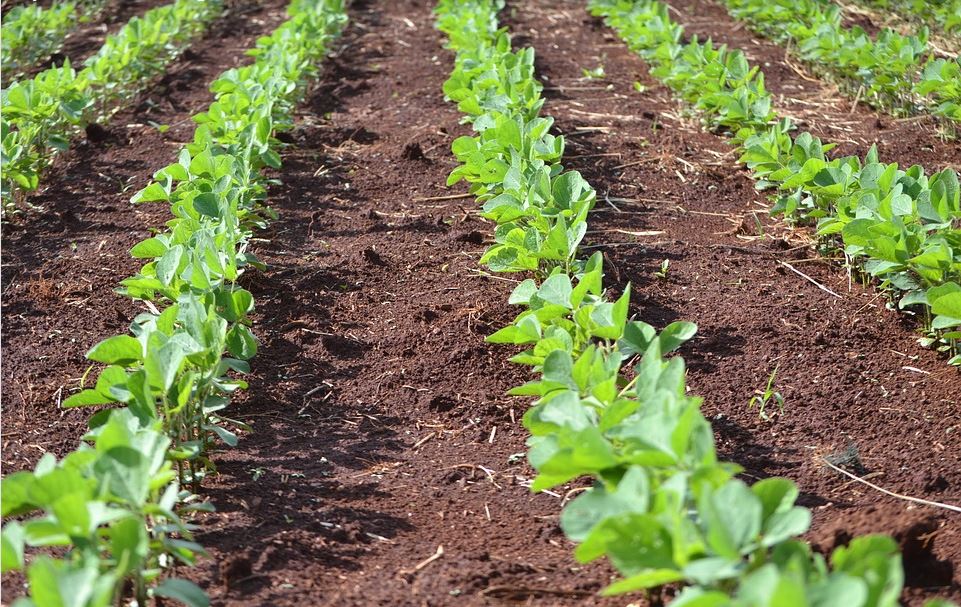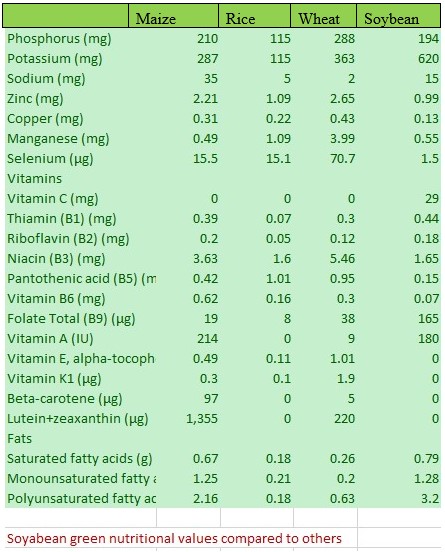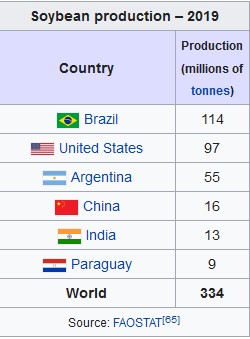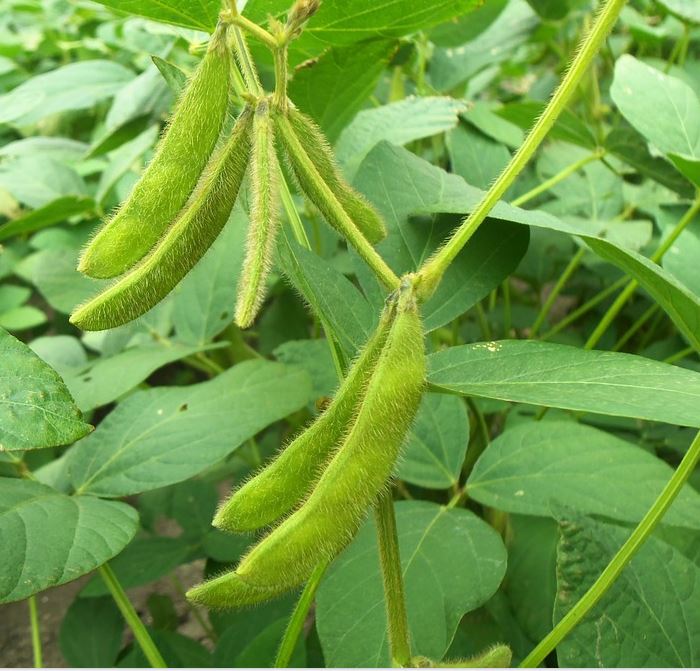
Soybeans – Farming and Uses
INTRODUCTION
Soybeans originated in Southeast Asia and were first domesticated by Chinese farmers around 1100 BC. By the first century AD, soybeans were grown in Japan and many other countries. The soybean or soy bean (Glycine max) is a species of legume native to East Asia, widely grown for its edible bean, which has numerous uses.
By the 17th century through trade with Far East, soybeans and its products were traded by European traders (Portuguese, Spanish, and Dutch) in Asia, and supposedly reached Indian Subcontinent by this period.
By the 18th century, soybeans were introduced to the Americas and Europe from China. Soy was introduced to Africa from China in the late 19th century, and is now widespread across the continent.
In 1990s due to advancement of science and research, herbicide resistant variety of Soybean was made available to the farmers. The farmers with such variety could use weedicides safely without danger to their soybean plants. This also meant greater freedom from mechanical and/or manual weeding of the crops reducing costs.
They are now a major crop in the United States, Brazil, Argentina, India, China and almost all over world. It is great for crop rotation. Soy is a high protein food and also used as sauce, bean curd, soy milk, tempeh, natto and miso.
Soybeans are one of the biotech food crops that have been genetically modified and the same are being used in a number of products. Although various countries ban the use of genetically modified seeds, the use is prevalent as they are less susceptible to infestations and diseases.
Soybean Cultivation
Sowing times for Soybean Crop
Soybeans can grow in wide range of soils; for best production grow in rich organic soils. Add suitable bacteria as is done in the case of other legumes.
India has two seasons of cultivation in both kharif and summer seasons. Spring sowing done between 15th Feb to 15th March. Kharif crop is sown with onset of monsoon of last week of June to first week of July.
Climatic requirement
Soybean requires climates with warm and moist summers with optimum growing conditions in mean temperatures of 20 to 30 degree centigrade. Temperatures outside this range stunt the growth.
Soil Requirements
Soybean can be grown on a variety of soils ranging from sandy loam to black cotton soils having good drainage capacity. Soil should be well drained and fertile. A pH range between 6.0 and 7.5 is favorable for its cultivation..
Land Preparation for soybean farming
Prepare field by one or two ploughing followed by two or three cross harrowing and planking. The field should be well leveled and free from weeds and stubble. For summer season crop, pre-sowing irrigation should be given immediately after harvesting of the previous crop. Field should be leveled to minimize the loss of moisture by evaporation from the soil. One feet wide ridges and furrows or beds and channels of appropriate width are good for optimizing soybean production. If sown for fodder purpose, density of seed is increased.
Fertilizer Application to Beds
15 to 25 T/ha well decomposed farm yard manure (FYM) should be incorporated into soil at the time of preparation of the land. Apply 50 kg/ha N, 150 kg/ha Phosphate, 25 kg/ha Potash in summer crops in irrigated land. Apply Zinc sulfate and Borax in small quantities.
A word of advice — It is always advisable to have a soil water analysis done for deciding on actual quantity of application of inorganic fertilizers to avoid wastage.
Do this Also – seed treatment
Before sowing, seeds should be treated with Thiram or Captan @ 2 to 3 g/kg of seeds.
Mix the seeds in 10% cooled jaggery solution mixed with Rhizobium bio fertilizer(3) @ 20-30 g/kg.Dry for 6-8 hr in shade and sow the seeds within 12 hrs.
Seed Spacing
Seeds are spaced at at about 5 cm plant to plant and distanced 45 cm line to line for kharif crop and at 30 cm x 10 cm for Rabi and summer.
Seed Rate:
Use about 12 to 16 kg/ha in kharif season and 20-25 kg/ha Rabi and summer seasons. Depth of seeds is around 2 -3 cm in heavy soils. In light soils, keep depth around 3 -4 cm.
Seed sowing is either (a) Manual (Broadcasting, Line Sowing) or (b) Mechanical (Seed drill).
Irrigation
For rain fed crop, irrigation is not needed but soil drainage is important.
For summer season crop, five to six irrigation may be given. First irrigation should be given at 20-25 days after sowing and subsequent irrigation should be given at an interval of 12-15 days.
Irrigation should not be given at full bloom stage of the crop. Late flowering and early pod filling stages are critical stages for irrigation.
Weed Control in Soybean Farming
One or two inter-culturing and one to two weeding should be carried out at 20 and 45 days after sowing. Use appropriate weedicide, as a spray or mixed with sand, immediately after sowing of the seeds.
Methods of cropping
Soybean can be mixed with maize, sesamum etc. it can be inter cropped with lentils, cotton, sugarcane and rotated with wheat, potato, gram, tobacco.
.
Pests and Diseases Control
Major pest are borers which make holes in young pods and eats the seeds. Hand collection and disposal can be done. Spray with Dimethoate or Phosphomidan @ 2 ml/liter of water.
Use Bavistin or M45 for diseases like wilting. Powdery Mildew is also a threat which can be controlled by spraying Dithane M45.
One may also refer to my blog Diseases and Pests.
Nutritional Value of Soybeans
Table below shows a comparison of nutrients, vitamins and fats (courtesy: wikipedia)

Approximate Yield
Depending on the variety selected and the season, farmers can expect a yield of 18 to 35 quintals/ha.
World Production

Uses of Soybeans
Soybean is an excellent source of high quality protein. It is consumed in different ways as tofu, sauce, nuggets and so many other preparations. Additionally it has vitamin C and other minerals and nutrients as brought out in table.
Being a short duration crop it also provides an excellent green fodder to the animals. Soybean is a leguminous crop. It has the capacity to fix atmospheric nitrogen through symbiotic nitrogen fixation. It is also used as green manure crop.
Soybeans fit well in various multiple and inter cropping systems. After picking of pods, Soybean plants may be used as green fodder or can be incorporated as green manure.
When to Harvest Soybean
Soybean matures from 55 to 145 days depending on the variety which has been sown. Fruits can be harvested once in 3 to 4 days. Maturity of crop is indicated when leaves turn yellow and drop and pods dry out. Harvesting is done by sickle and then threshing is done to get soybeans. .
For Soybean harvest early morning hours are best suited . After harvest fruits should be kept in cool place and avoid direct exposure to sunlight.
Harvesting before the maturity of crop, usually result in lower yields, while delayed harvesting results in shattering of pods and other losses caused by pests. Harvesting during rains and overcast weather invitation to fungal infection.
References: wikipedia
1. Rabi crop:Rabi cropping season is from October-March (winter)
2. Kharif crop: Kharif cropping season is from July –October during south-west monsoon in India.
3. Rhizobium: bacteria associated with the formation of root nodules on plants. These bacteria live in symbiosis with legumes. They take in nitrogen from the atmosphere and pass it on to the plant, allowing it to grow in soil low in nitrogen.



Leave a Reply